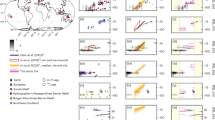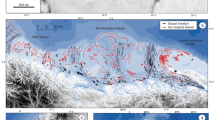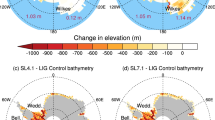Abstract
Past sea-level records provide invaluable information about the response of ice sheets to climate forcing. Some such records suggest that the last deglaciation was punctuated by a dramatic period of sea-level rise, of about 20 metres, in less than 500 years. Controversy about the amplitude and timing of this meltwater pulse (MWP-1A) has, however, led to uncertainty about the source of the melt water and its temporal and causal relationships with the abrupt climate changes of the deglaciation. Here we show that MWP-1A started no earlier than 14,650 years ago and ended before 14,310 years ago, making it coeval with the Bølling warming. Our results, based on corals drilled offshore from Tahiti during Integrated Ocean Drilling Project Expedition 310, reveal that the increase in sea level at Tahiti was between 12 and 22 metres, with a most probable value between 14 and 18 metres, establishing a significant meltwater contribution from the Southern Hemisphere. This implies that the rate of eustatic sea-level rise exceeded 40 millimetres per year during MWP-1A.
This is a preview of subscription content, access via your institution
Access options
Subscribe to this journal
Receive 51 print issues and online access
$199.00 per year
only $3.90 per issue
Buy this article
- Purchase on SpringerLink
- Instant access to full article PDF
Prices may be subject to local taxes which are calculated during checkout



Similar content being viewed by others
References
Milne, G. A., Gehrels, W. R., Hughes, C. W. & Tamisiea, M. E. Identifying the causes of sea-level change. Nature Geosci. 2, 471–478 (2009)
Pfeffer, W. T., Harper, J. T. & O’Neel, S. Kinematic constraints on glacier contributions to 21st-century sea-level rise. Science 321, 1340–1343 (2008)
Meehl, G. A. et al. in Climate Change 2007: The Physical Science Basis (eds Solomon, S. et al.) 747–845 (Cambridge Univ. Press, 2007)
Alley, R. B., Clark, P. U., Huybrechts, P. & Joughin, I. Ice-sheet and sea-level changes. Science 310, 456–460 (2005)
Fairbanks, R. G. A 17,000-year glacio-eustatic sea level record; influence of glacial melting rates on the Younger Dryas event and deep-ocean circulation. Nature 342, 637–642 (1989)
Bard, E., Hamelin, B. & Fairbanks, R. G. U-Th ages obtained by mass spectrometry in corals from Barbados: sea level during the past 130,000 years. Nature 346, 456–458 (1990)
Blanchon, P. & Shaw, J. Reef drowning during the last deglaciation: evidence for catastrophic sea-level rise and ice-sheet collapse. Geology 23, 4–8 (1995)
Hanebuth, T., Stattegger, K. & Grootes, P. M. Rapid flooding of the Sunda Shelf: a late-glacial sea-level record. Science 288, 1033–1035 (2000)
Yokoyama, Y., Lambeck, K., De Deckker, P., Johnston, P. & Fifield, L. K. Timing of the Last Glacial Maximum from observed sea-level minima. Nature 406, 713–716 (2000)
Clark, P. U., McCabe, A. M., Mix, A. C. & Weaver, A. J. Rapid rise of sea level 19,000 years ago and its global implications. Science 304, 1141–1144 (2004)
Manabe, S. & Stouffer, R. J. Simulation of abrupt climate change induced by freshwater input to the North Atlantic Ocean. Nature 378, 165–167 (1995)
Weaver, A. J., Saenko, O. A., Clark, P. U. & Mitrovica, J. X. Meltwater pulse 1A from Antarctica as a trigger of the Bølling-Allerød warm interval. Science 299, 1709–1713 (2003)
Bamber, J. L., Riva, R. E. M., Vermeersen, B. L. A. & LeBrocq, A. M. Reassessment of the potential sea-level rise from a collapse of the West Antarctic Ice Sheet. Science 324, 901–903 (2009)
Bard, E. et al. Deglacial sea-level record from Tahiti corals and the timing of global meltwater discharge. Nature 382, 241–244 (1996)
Webster, J. M. et al. Drowning of the −150 m reef off Hawaii: a casualty of global meltwater pulse 1A? Geology 32, 249–252 (2004)
Stanford, J. D. et al. Timing of meltwater pulse 1a and climate responses to meltwater injections. Paleoceanography 21, PA4103, http://dx.doi.org/10.1029/2006PA001340 (2006)
Clark, P. U. et al. Origin of the first global meltwater pulse following the last glacial maximum. Paleoceanography 11, 563–577 (1996)
Peltier, W. R. On the hemispheric origins of meltwater pulse 1a. Quat. Sci. Rev. 24, 1655–1671 (2005)
Peltier, W. R. & Fairbanks, R. G. Global glacial ice volume and Last Glacial Maximum duration from an extended Barbados sea level record. Quat. Sci. Rev. 25, 3322–3337 (2006)
Bassett, S. E., Milne, G. A., Mitrovica, J. X. & Clark, P. U. Ice sheet and solid earth influences on far-field sea-level histories. Science 309, 925–928 (2005)
Kienast, M., Hanebuth, T. J. J., Pelejero, C. & Steinke, S. Synchroneity of meltwater pulse 1a and the Bølling warming: new evidence from the South China Sea. Geology 31, 67–70 (2003)
McManus, J. F., Francois, R., Gherardi, J. M., Keigwin, L. D. & Brown-Leger, S. Collapse and rapid resumption of Atlantic meridional circulation linked to deglacial climate changes. Nature 428, 834–837 (2004)
Camoin, G., Iryu, Y. & McInroy, D. &. Expedition 310 Scientists. Expedition 310. Proc. IODP Vol. 310 Expedition Reports http://dx.doi.org/10.2204/iodp.proc.310.2007 (2007)
Bard, E., Hamelin, B. & Delanghe-Sabatier, D. Deglacial meltwater pulse 1B and Younger Dryas sea levels revisited with boreholes at Tahiti. Science 327, 1235–1237 (2010)
Blanchon, P. & Blakeway, D. Are catch-up reefs an artefact of coring? Sedimentology 50, 1271–1282 (2003)
Cabioch, G., Montaggioni, L. F., Faure, G. & Ribaud-Laurenti, A. Reef coralgal assemblages as recorders of paleobathymetry and sea level changes in the Indo-Pacific province. Quat. Sci. Rev. 18, 1681–1695 (1999)
Milne, G. A. & Mitrovica, J. X. Searching for eustasy in deglacial sea-level histories. Quat. Sci. Rev. 27, 2292–2302 (2008)
Peltier, W. R. On eustatic sea level history: Last Glacial Maximum to Holocene. Quat. Sci. Rev. 21, 377–396 (2002)
Fairbanks, R. G. et al. Radiocarbon calibration curve spanning 0 to 50,000 years BP based on paired 230Th/234U/238U and 14C dates on pristine corals. Quat. Sci. Rev. 24, 1781–1796 (2005)
Reimer, P. J. et al. Intcal09 and Marine09 radiocarbon age calibration curves, 0–50,000 years cal BP. Radiocarbon 51, 1111–1150 (2009)
Edwards, R. L. et al. A large drop in atmospheric 14C/12C and reduced melting in the Younger Dryas, documented with 230Th ages of corals. Science 260, 962–968 (1993)
Cutler, K. B. et al. Rapid sea-level fall and deep-ocean temperature change since the last interglacial period. Earth Planet. Sci. Lett. 206, 253–271 (2003)
Liu, J. P. & Milliman, J. D. Reconsidering meltwater pulses 1A and 1B: global impacts of rapid sea level rise. J. Ocean Univ. China 3, 183–190 (2004)
Rasmussen, T. L. et al. A new Greenland ice core chronology for the last glacial termination. J. Geophys. Res. 111, D06102, http://dx.doi.org/10.1029/2005JD006079 (2006)
Peltier, W. R. Ice-age paleotopography. Science 265, 195–201 (1994)
Clark, P. U., Mitrovica, J. X., Milne, G. A. & Tamisiea, M. E. Sea-level fingerprinting as a direct test for the source of global meltwater pulse IA. Science 295, 2438–2441 (2002)
Bassett, S. E., Milne, G. A., Bentley, M. J. & Huybrechts, P. Modelling Antarctic sea-level data to explore the possibility of a dominant Antarctic contribution to meltwater pulse IA. Quat. Sci. Rev. 26, 2113–2127 (2007)
Carlson, A. E. Geochemical constraints on the Laurentide Ice Sheet contribution to Meltwater Pulse 1A. Quat. Sci. Rev. 28, 1625–1630 (2009)
Tarasov, L. & Peltier, W. R. A calibrated deglacial drainage chronology for the North American continent: evidence of an Arctic trigger for the Younger Dryas. Quat. Sci. Rev. 25, 659–688 (2006)
Clark, P. U. & Mix, A. C. Ice sheets and sea level of the Last Glacial Maximum. Quat. Sci. Rev. 21, 1–7 (2002)
Denton, G. H. & Hughes, T. J. Reconstructing the Antarctic Ice Sheet at the Last Glacial Maximum. Quat. Sci. Rev. 21, 193–202 (2002)
Bentley, M. J. The Antarctic palaeo record and its role in improving predictions of future Antarctic Ice Sheet change. J. Quat. Sci. 25, 5–18 (2010)
Swingedouw, D., Fichefet, T., Goosse, H. & Loutre, M. F. Impact of transient freshwater releases in the Southern Ocean on the AMOC and climate. Clim. Dyn. 33, 365–381 (2009)
Aharon, P. Entrainment of meltwaters in hyperpycnal flows during deglaciation superfloods in the Gulf of Mexico. Earth Planet. Sci. Lett. 241, 260–270 (2006)
Roche, D. M., Renssen, H., Weber, S. L. & Goosse, H. Could meltwater pulses have been sneaked unnoticed into the deep ocean during the last glacial? Geophys. Res. Lett. 34, L24708, http://dx.doi.org/10.1029/2007GL032064 (2007)
Tarasov, L. & Peltier, W. R. Arctic freshwater forcing of the Younger Dryas cold reversal. Nature 435, 662–665 (2005)
Knorr, G. & Lohmann, G. Southern Ocean origin for the resumption of Atlantic thermohaline circulation during deglaciation. Nature 424, 532–536 (2003)
Knorr, G. & Lohmann, G. Rapid transitions in the Atlantic thermohaline circulation triggered by global warming and meltwater during the last deglaciation. Geochem. Geophys. Geosyst. 8, Q12006, http://dx.doi.org/10.1029/2007GC001604 (2007)
Andersen, M. B. et al. The tracing of riverine U in Arctic seawater with very precise 234U/238U measurements. Earth Planet. Sci. Lett. 259, 171–185 (2007)
Thomas, A. L. et al. Penultimate deglacial sea-level timing from uranium/thorium dating of Tahitian corals. Science 324, 1186–1189 (2009)
Acknowledgements
We thank the IODP and ECORD (European Consortium for Ocean Research Drilling) for drilling offshore from Tahiti, and the Bremen Core Repository members for organizing the onshore sampling party. We dedicate this article to the memory of G. Cabioch, who died at the end of 2011: a reef geology expert, he was a member of the IODP expedition to Tahiti. The CEREGE group thanks W. Barthelemy for maintaining mass spectrometers; D. Borschneck for help with X-ray diffraction analyses; and P. Dussouillez for help with maps. Palaeoclimate work at CEREGE is supported by the Comer Science and Education Foundation, the European Science Foundation (EuroMARC), the European Community (Project Past4Future), the Collège de France and the IRD (Institut de Recherche pour le Développement). The Oxford University team is supported by UK Natural Environment Research Council grant NE/D001250/1 and the Comer Science and Education Foundation. The University of Tokyo group is partly supported by JSPS (NEXT program GR031).
Author information
Authors and Affiliations
Contributions
G.C., E.B. and B.H. were Principal Investigators for ODP proposal 519 designing this study. G.C. was co-chief scientist of IODP Expedition 310. P.D. and A.L.T. participated in the IODP sampling party. N.D., P.D. and A.L.T. performed U–Th dating of coral samples; N.D. performed X-ray diffraction analyses and reef growth modelling simulations; J.O. and Y.Y. performed geophysical modelling simulations; P.D. wrote the manuscript in collaboration with E.B. and B.H. The paper was refined by contributions from N.D., A.L.T., G.M.H. and G.C.
Corresponding author
Ethics declarations
Competing interests
The authors declare no competing financial interests.
Supplementary information
Supplementary Information
This file contains Supplementary Text, Supplementary Figures 1-11, Supplementary Tables 1-2 and additional references. (PDF 7486 kb)
Rights and permissions
About this article
Cite this article
Deschamps, P., Durand, N., Bard, E. et al. Ice-sheet collapse and sea-level rise at the Bølling warming 14,600 years ago. Nature 483, 559–564 (2012). https://doi.org/10.1038/nature10902
Received:
Accepted:
Published:
Issue Date:
DOI: https://doi.org/10.1038/nature10902



